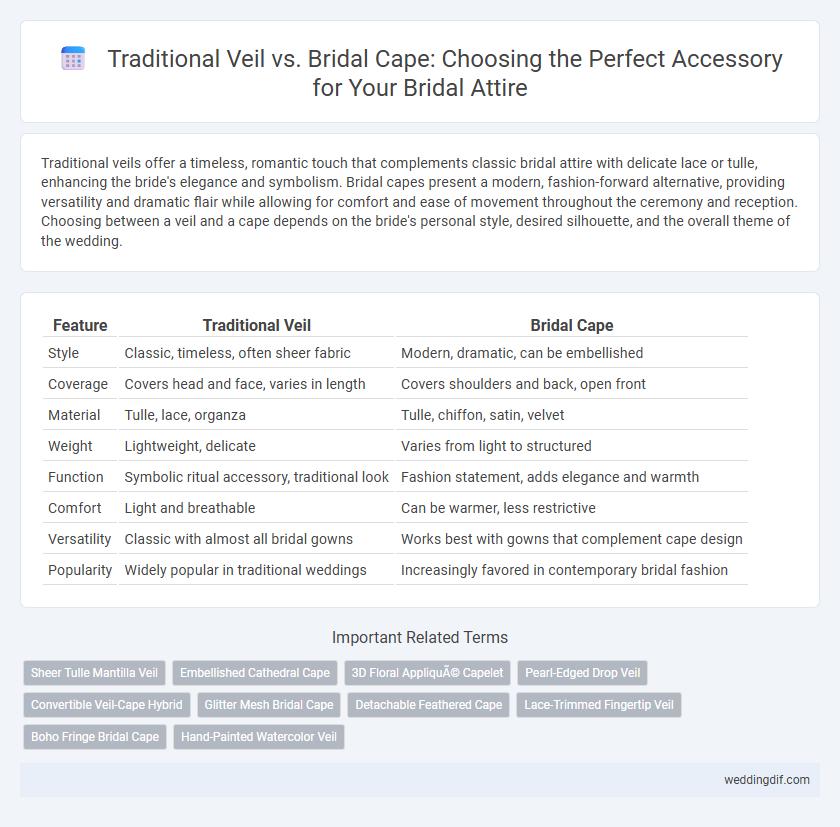Traditional veils offer a timeless, romantic touch that complements classic bridal attire with delicate lace or tulle, enhancing the bride's elegance and symbolism. Bridal capes present a modern, fashion-forward alternative, providing versatility and dramatic flair while allowing for comfort and ease of movement throughout the ceremony and reception. Choosing between a veil and a cape depends on the bride's personal style, desired silhouette, and the overall theme of the wedding.
Table of Comparison
| Feature | Traditional Veil | Bridal Cape |
|---|---|---|
| Style | Classic, timeless, often sheer fabric | Modern, dramatic, can be embellished |
| Coverage | Covers head and face, varies in length | Covers shoulders and back, open front |
| Material | Tulle, lace, organza | Tulle, chiffon, satin, velvet |
| Weight | Lightweight, delicate | Varies from light to structured |
| Function | Symbolic ritual accessory, traditional look | Fashion statement, adds elegance and warmth |
| Comfort | Light and breathable | Can be warmer, less restrictive |
| Versatility | Classic with almost all bridal gowns | Works best with gowns that complement cape design |
| Popularity | Widely popular in traditional weddings | Increasingly favored in contemporary bridal fashion |
Overview: Traditional Veil vs Bridal Cape
Traditional veils in bridal attire symbolize timeless elegance and often feature delicate lace or tulle, cascading softly over the bride's face or shoulders. Bridal capes offer a modern alternative, providing a dramatic silhouette with flowing fabrics or intricate embellishments that complement the gown. Both elements enhance the bridal look but differ in style, coverage, and the overall statement they create during the wedding ceremony.
Historical Significance of the Bridal Veil
The bridal veil holds deep historical significance, symbolizing purity, modesty, and protection from evil spirits in many cultures throughout centuries. Originating in ancient Rome and evolving through Victorian-era customs, the veil has been a timeless emblem of bridal tradition and spiritual meaning. While the bridal cape offers a modern, elegant alternative, it lacks the rich historical symbolism embedded in the centuries-old use of the veil in wedding ceremonies.
Modern Rise of the Bridal Cape
The modern rise of the bridal cape offers a chic alternative to the traditional veil, blending contemporary fashion with timeless elegance in bridal attire. Bridal capes provide versatility and dramatic flair, often featuring intricate lace or sheer fabrics that complement various dress styles while allowing for greater movement. Designers increasingly favor capes for their ability to create a unique bridal silhouette that stands out in wedding photography and ceremonial moments.
Aesthetic Appeal: Comparing Veil and Cape Styles
Traditional veils offer a timeless, delicate aesthetic with sheer fabrics and intricate lace that frame the bride's face and add an ethereal touch. Bridal capes provide a modern, dramatic silhouette with flowing or structured designs that enhance the overall gown while allowing more freedom of movement. Both styles elevate bridal attire, but veils emphasize romance and tradition, whereas capes highlight bold sophistication and contemporary elegance.
Symbolism: What Each Accessory Represents
Traditional bridal veils symbolize purity, modesty, and the bride's transition from singlehood to marriage, rooted in centuries-old customs and cultural significance. Bridal capes represent modern elegance and empowerment, often symbolizing strength and individuality, allowing brides to make a bold fashion statement while honoring contemporary values. Both accessories carry deep symbolic meanings that reflect different aspects of the bride's identity and the marital journey.
Comfort and Practicality for the Bride
Traditional veils offer a lightweight and breathable option, allowing easy movement and minimal disturbance during the ceremony. Bridal capes provide greater coverage and can enhance the bridal silhouette while remaining comfortable for extended wear due to their flexible fabric and secure fit. Choosing between a veil and a cape depends on the bride's preference for ease of adjustment and the overall flow of the bridal ensemble.
Bridal Cape and Veil: Styling Tips
Bridal capes offer a modern, elegant alternative to traditional veils, enhancing silhouette with flowing fabric and intricate embellishments that complement varied gown styles. Veils provide timeless romance through layers of tulle, lace, or delicate beadwork, framing the face and adding ethereal softness to bridal portraits. When styling, pair capes with minimalist gowns to emphasize their dramatic flair, while veils suit ornate dresses by balancing intricate details with subtle, graceful accents.
Customization and Personalization Options
Traditional veils offer intricate lace, beadwork, and embroidery that can be customized to match the bride's gown details and family heritage, providing a timeless, sentimental touch. Bridal capes present a modern alternative with versatile designs that can incorporate personalized fabrics, detachable trains, and unique closures, allowing brides to express individuality while maintaining elegance. Both options enable tailored embellishments, ensuring the bridal attire reflects personal style and meaningful customization.
Seasonal Suitability: Veil or Cape?
Traditional veils offer lightweight, breathable coverage ideal for spring and summer weddings, allowing air circulation while maintaining elegance. Bridal capes provide versatile warmth and dramatic flair perfect for fall and winter ceremonies, often crafted from heavier fabrics like velvet or lace-lined tulle. Choosing between veil and cape depends on weather conditions and desired seasonal style, balancing comfort and aesthetic appeal.
Which Suits Your Wedding Theme Best?
Traditional veils offer a timeless elegance that complements classic and romantic wedding themes, enhancing the bride's silhouette with delicate lace or tulle details. Bridal capes provide a modern yet regal alternative, ideal for contemporary or dramatic ceremonies, adding a statement piece that flows gracefully and can be personalized with intricate embellishments. Consider the overall wedding aesthetic and venue when choosing between these two, as veils suit intimate church weddings while capes perfectly accentuate grand outdoor or ballroom celebrations.
Traditional Veil vs Bridal Cape for Bridal Attire Infographic

 weddingdif.com
weddingdif.com